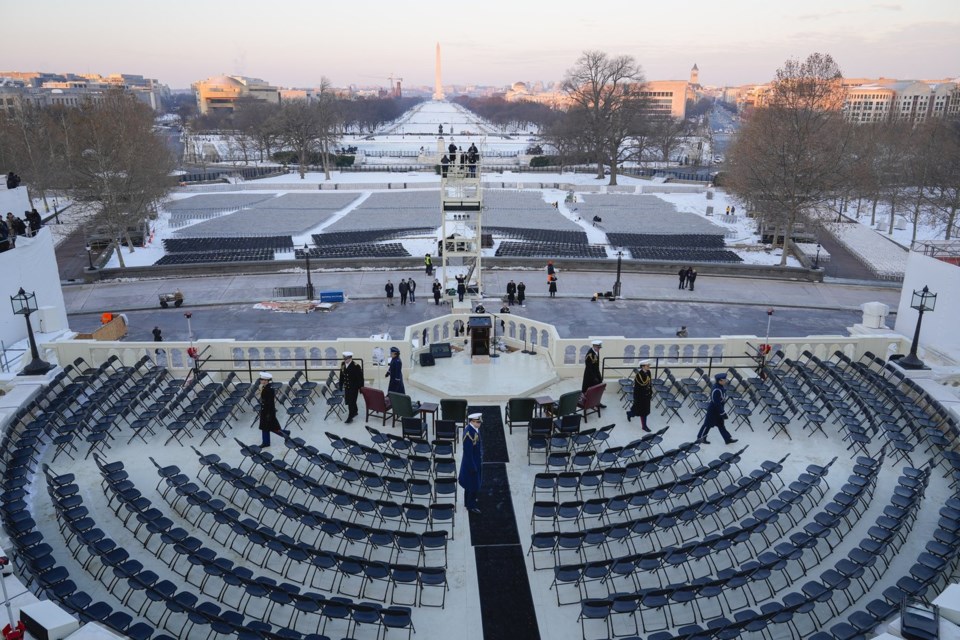NEW ORLEANS (AP) — The vast majority of Americans are about to get an extended taste of frigid Siberian weather. Another polar vortex disruption will stretch Arctic air across the top of the globe and make Donald Trump's second inauguration the coldest in 40 years, meteorologists said.
After starting in the Rockies Thursday night, the cold will blast eastward and as far south as the upper Florida peninsula over several days. Up to 280 million Americans will have a day or two where it’s colder than Anchorage, Alaska, said private meteorologist Ryan Maue.
“This would be one of the coldest outbreaks certainly of the past 10 years, 15 years,” said winter weather expert Judah Cohen of Atmospheric Environmental Research. “It’s pulling air out of Siberia. And, you know, that’s consistent with these stretches because when the polar vortex stretches, the flow starts in Siberia and ends in the United States.”
It will arrive in Washington well before Trump's inauguration Monday outside the U.S. Capitol. The National Weather Service is predicting the temperature to be around 22 degrees (minus-6 Celsius) at noon during the swearing-in, the coldest since Ronald Reagan's second inauguration saw temperatures plunge to 7 degrees (minus-14 Celsius). Barack Obama 2009 swearing-in was 28 degrees (minus-2 Celsius).
But that's not all because the wind is forecast to be 30 to 35 mph (48 to 56 kph).
“The wind chills would be in the single digits for sure,” the NWS' Weather Prediction Center meteorologist Zack Taylor said. “That’s going to be cold, blustery, basically right up the National Mall. And it can get pretty breezy on the mall there with the west-northwest wind right in the face.”
Washington could see single digits later and on Wednesday morning might get near zero, Maue said. There could be a record low broken in Baltimore, Taylor said. He said most of the records that will be broken in this cold outbreak are not likely to be overnight lows, but still chilly daytime highs.
About 80 million people are likely to have subzero temperatures at some point, Maue said.
"The coldest will be Tuesday morning for the Lower 48 overall," Maue said. The average low that morning for the entire Lower 48 will be around 7 degrees (minus-14 degrees Celsius), he said.
Maue said a stretch from Chicago to Indianapolis to Columbus, Ohio, to Pittsburgh will get the most brutal cold compared to their normal temperatures.
“That’s like a corridor of extreme cold, calm winds at night over snow cover. Temperatures could really drop like a rock there,” Maue said.
Freezes could go as far as the Gulf Coast and northern Florida, meteorologists said.
Earlier this month, long-range forecasts hinted at worst-in-30-years type of cold for the year's first week, but those predictions eased as the cold outbreak got closer. It was cold, but not near record levels. This time, it’s the opposite. Each day’s computer models show it colder than the previous one, Maue said.
There's some possibility of snow squalls here and there, but it's mostly just going to be cold, Taylor said — what Maue called a dry cold.
As happened earlier this month, this cold snap comes from a disruption in the polar vortex, the ring of cold air usually trapped about the North Pole. That ring is being stretched south across North America like a rubber band, Cohen said.
These stretching events are or so, Cohen said. He and others have linked these and decreasing pressure and temperature differences between the Arctic and the rest of the globe.
Those also trigger changes in the jet stream — the river of air that usually brings weather from west to east — that make cold air and weather systems plunge from north to south like a roller coaster.
On the east side of that plunge is cold air and potentially record high pressure, Taylor and others said.
On the west side, in southern California, is not only warmer air but also the extreme pressure differences that could goose the already high winds that are fanning fires around Los Angeles, meteorologists said.
Get used to it. There's some debate among meteorologists about how long this extreme cold outbreak will last but below normal temperatures may stick around through the end of the month for much of the country, said University of Oklahoma meteorology professor Jason Furtado, who organized winter weather workshops at the American Meteorological Society's annual conference in New Orleans.
And Cohen said long-range forecasts suggest the same polar vortex conditions could return in early February.
___
Read more of AP’s climate coverage at
___
Follow Seth Borenstein on X at
_____
The Associated Press’ climate and environmental coverage receives financial support from multiple private foundations. AP is solely responsible for all content. Find AP’s for working with philanthropies, a list of supporters and funded coverage areas at .
Seth Borenstein, The Associated Press




